Henryk Siemiradzki
| Henryk Siemiradzki | |
|---|---|
|
Henryk Siemiradzki in later life | |
| Born |
Henryk Siemiradzki October 24, 1843 Belgorod, Kharkov Governorate, Russian Empire |
| Died |
August 23, 1902 (aged 58) Strzałków, Congress Poland |
| Nationality | Polish |
| Education | Imperial Academy of Arts |
| Known for | Painting |
| Notable work |
Nero's Torches, curtain for the Juliusz Słowacki Theatre in Kraków, curtain for the Lwów Theatre |
| Movement | Academism |
Henryk Hektor Siemiradzki (24 October 1843 – 23 August 1902) was a Rome-based Polish painter, best remembered for his monumental Academic art. He was particularly known for his depictions of scenes from the ancient Graeco-Roman world and the New Testament, owned by national galleries of Poland, Ukraine and Russia.[1][2]
Many of his paintings depict scenes from antiquity, often the sunlit pastoral scenes or compositions presenting the lives of early Christians. He also painted biblical and historical scenes, landscapes, and portraits. His best-known works include monumental curtains for the Lviv (Lwów) Theatre of Opera and for the Juliusz Słowacki Theatre in Kraków.
Biography
Siemiradzki was born to a Polish noble family of an officer (since 1871 a General) of the Imperial Russian Army, Hipolit Siemiradzki, and Michalina (née Prószyńska) in Belgorod (now Pechenihy, Kharkiv oblast, Ukraine),[3][4] near the city of Kharkiv, where his father's regiment was stationed.[5] The family had origins in Radom land and derived its name from the village of Siemiradz. One of the branches settled in the late 17th century near Navahrudak (Nowogródek). Henryk's grandfather held the post of podkomorzy in Nowogródek powiat. His parents were close friends with Adam Mickiewicz's family. He studied at Kharkiv Gymnasium where he first learned painting under the local school teacher, D.I. Besperchy, former student of Karl Briullov. He entered the Physics-Mathematics School of Kharkiv University and studied natural sciences there with great interest, but also continued to paint.[3][6]
Siemiradzki's artistic career

After graduating from the University with the degree of Kandidat he abandoned his scientific career and moved to Saint Petersburg to study painting at the Imperial Academy of Arts in the years 1864–1870. Upon his graduation he was awarded a gold medal. In 1870–1871 he studied under Karl von Piloty in Munich on a grant from the Academy. In 1872 he moved to Rome and with time, built a studio there on Via Gaeta, while spending summers at his estate in Strzałkowo near Częstochowa in Poland.
In 1873 he received the title of Academician of the Imperial Academy of Arts for his painting Christ and a Sinner, based on a verse from Tolstoy. In 1878 he received the French National Order of the Legion of Honour and a Gold Medal of the Paris World's fair for the painting Flower vase. In 1876–1879 Siemiradzki worked on frescoes for the Cathedral of Christ the Saviour (Moscow) among his other large-scale projects. In 1879 he offered one of his best-known works, the enormous Pochodnie Nerona (Nero's torches), painted around 1876, to the newly formed Polish National Museum. The artwork is on display at the Siemiradzki Room of the Sukiennice Museum in the Kraków Old Town, the most popular branch of the museum today. Around 1893 Siemiradzki worked on two large paintings for the State Historical Museum (Moscow) and in 1894 produced his monumental curtain for the Juliusz Słowacki Theatre in Kraków.[2]
He died in Strzałków in 1902 and was buried originally in Warsaw, but later his remains were moved to the national Pantheon on Skałka in Kraków.
Siemiradzki modern arts gallery
There is the Modern Arts Gallery named after Henryk Siemiradzki at V.N. Karazin Kharkiv National University in Kharkiv, Ukraine.[7] Also there is a memorial plate about Henryk Siemiradzki in Kharkiv, Ukraine.[8]
Siemiradzki's monumental paintings
Henryk Siemiradzki's large-scale canvasses, influenced by the French Académie des Beaux-Arts, are on display at the national museums of Poland, Russia and Ukraine; notably, at the Sukiennice Museum, the National Museum, Poznań, Lviv National Art Gallery, Tretyakov Gallery and others.
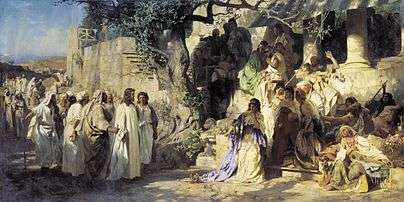 Christ and Sinner, version of 1875
Christ and Sinner, version of 1875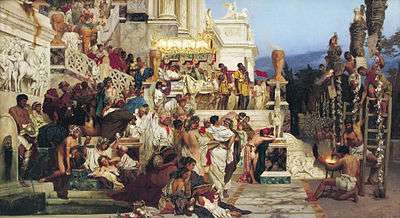 Nero's Torches, 1877
Nero's Torches, 1877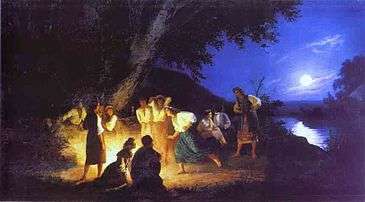 Night on the eve of Ivan Kupala, 1880s
Night on the eve of Ivan Kupala, 1880s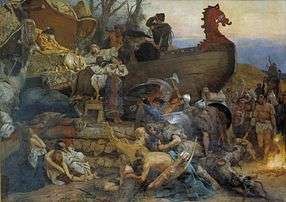 Burial of a Varangian Chieftain, 1883
Burial of a Varangian Chieftain, 1883 Christian Dirce, 1897
Christian Dirce, 1897
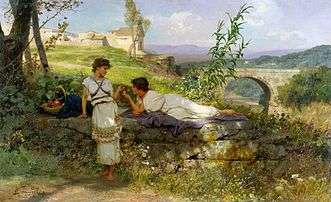 The Talisman, 1880s
The Talisman, 1880s Christ and Samaritan, 1890
Christ and Samaritan, 1890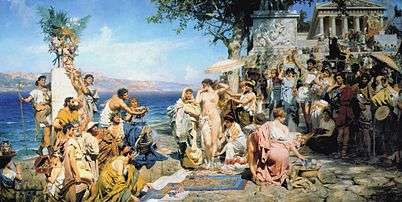 Phryne at the Poseidonia in Eleusis, 1889
Phryne at the Poseidonia in Eleusis, 1889
- National theatres
 Curtain for the Juliusz Słowacki Theatre in Kraków
Curtain for the Juliusz Słowacki Theatre in Kraków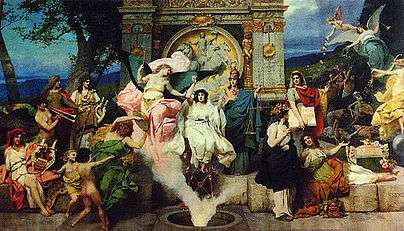 Curtain for the Lviv Theatre of Opera and Ballet
Curtain for the Lviv Theatre of Opera and Ballet
Notes and references
- ↑ Henryk Siemiradzki. Selection of Works with Biography and Index, at Artyzm.com. Retrieved October 24, 2011.
- 1 2 Ewa Micke-Broniarek, Henryk Siemiradzki. Magazine "Culture.pl". National Museum, Warsaw, December 2004.
- 1 2 Mgr. Paweł Dudek, Henryk Siemiradzki, including Bibliography. Jan Długosz University, 2011 Histmag.org
- ↑ Stanisław Lorentz. The National Museum in Warsaw: painting. Arkady Publishers. 1990. p. 50.
- ↑ Paweł Klimow "Jest on, rzecz jasna, Polakiem i Polakiem pozostanie".* Kilka uwag do biografii Henryka Siemiradzkiego. "Nacjonalizm w sztuce i historii sztuki 1789-1950". Instytut Sztuki PAN. 1998. p. 129.
- ↑ Tomasz Rozum, Henryk Hektor Siemiradzki. Magazyn INFORMATOR. No. 89, 2006.
- ↑ http://www.univer.kharkov.ua/ru/general/univer_today/news?news_id=1696
- ↑ http://www.city.kharkov.ua/ru/news/u-kharkovi-vidkrili-memorialnu-doshku-genrikhu-semiradskomu-29760.html
External links
| Wikimedia Commons has media related to Henryk Siemiradzki. |
- Online gallery of Semiradsky paintings
- Works and Bio (Russian)
- Bio (Russian)
 Gilman, D. C.; Thurston, H. T.; Colby, F. M., eds. (1905). "Siemiradzki, Henryk". New International Encyclopedia (1st ed.). New York: Dodd, Mead.
Gilman, D. C.; Thurston, H. T.; Colby, F. M., eds. (1905). "Siemiradzki, Henryk". New International Encyclopedia (1st ed.). New York: Dodd, Mead. "Siemiradzki, Henryk". Encyclopedia Americana. 1920.
"Siemiradzki, Henryk". Encyclopedia Americana. 1920.